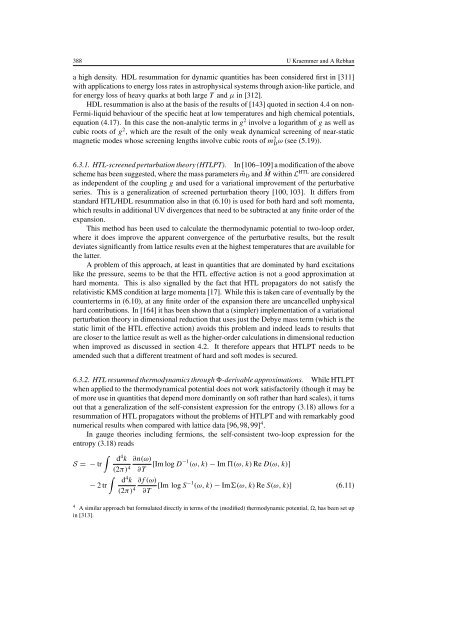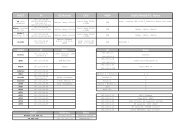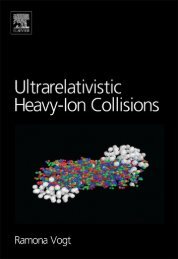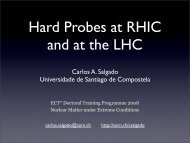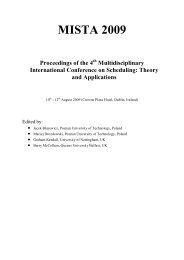Advances in perturbative thermal field theory - Ultra-relativistic ...
Advances in perturbative thermal field theory - Ultra-relativistic ...
Advances in perturbative thermal field theory - Ultra-relativistic ...
Create successful ePaper yourself
Turn your PDF publications into a flip-book with our unique Google optimized e-Paper software.
388 U Kraemmer and A Rebhan<br />
a high density. HDL resummation for dynamic quantities has been considered first <strong>in</strong> [311]<br />
with applications to energy loss rates <strong>in</strong> astrophysical systems through axion-like particle, and<br />
for energy loss of heavy quarks at both large T and µ <strong>in</strong> [312].<br />
HDL resummation is also at the basis of the results of [143] quoted <strong>in</strong> section 4.4 on non-<br />
Fermi-liquid behaviour of the specific heat at low temperatures and high chemical potentials,<br />
equation (4.17). In this case the non-analytic terms <strong>in</strong> g 2 <strong>in</strong>volve a logarithm of g as well as<br />
cubic roots of g 2 , which are the result of the only weak dynamical screen<strong>in</strong>g of near-static<br />
magnetic modes whose screen<strong>in</strong>g lengths <strong>in</strong>volve cubic roots of m 2 Dω (see (5.19)).<br />
6.3.1. HTL-screened perturbation <strong>theory</strong> (HTLPT). In [106–109] a modification of the above<br />
scheme has been suggested, where the mass parameters ˆm D and ˆM with<strong>in</strong> L HTL are considered<br />
as <strong>in</strong>dependent of the coupl<strong>in</strong>g g and used for a variational improvement of the <strong>perturbative</strong><br />
series. This is a generalization of screened perturbation <strong>theory</strong> [100, 103]. It differs from<br />
standard HTL/HDL resummation also <strong>in</strong> that (6.10) is used for both hard and soft momenta,<br />
which results <strong>in</strong> additional UV divergences that need to be subtracted at any f<strong>in</strong>ite order of the<br />
expansion.<br />
This method has been used to calculate the thermodynamic potential to two-loop order,<br />
where it does improve the apparent convergence of the <strong>perturbative</strong> results, but the result<br />
deviates significantly from lattice results even at the highest temperatures that are available for<br />
the latter.<br />
A problem of this approach, at least <strong>in</strong> quantities that are dom<strong>in</strong>ated by hard excitations<br />
like the pressure, seems to be that the HTL effective action is not a good approximation at<br />
hard momenta. This is also signalled by the fact that HTL propagators do not satisfy the<br />
<strong>relativistic</strong> KMS condition at large momenta [17]. While this is taken care of eventually by the<br />
counterterms <strong>in</strong> (6.10), at any f<strong>in</strong>ite order of the expansion there are uncancelled unphysical<br />
hard contributions. In [164] it has been shown that a (simpler) implementation of a variational<br />
perturbation <strong>theory</strong> <strong>in</strong> dimensional reduction that uses just the Debye mass term (which is the<br />
static limit of the HTL effective action) avoids this problem and <strong>in</strong>deed leads to results that<br />
are closer to the lattice result as well as the higher-order calculations <strong>in</strong> dimensional reduction<br />
when improved as discussed <strong>in</strong> section 4.2. It therefore appears that HTLPT needs to be<br />
amended such that a different treatment of hard and soft modes is secured.<br />
6.3.2. HTL resummed thermodynamics through -derivable approximations. While HTLPT<br />
when applied to the thermodynamical potential does not work satisfactorily (though it may be<br />
of more use <strong>in</strong> quantities that depend more dom<strong>in</strong>antly on soft rather than hard scales), it turns<br />
out that a generalization of the self-consistent expression for the entropy (3.18) allows for a<br />
resummation of HTL propagators without the problems of HTLPT and with remarkably good<br />
numerical results when compared with lattice data [96, 98, 99] 4 .<br />
In gauge theories <strong>in</strong>clud<strong>in</strong>g fermions, the self-consistent two-loop expression for the<br />
entropy (3.18) reads<br />
∫<br />
d 4 k ∂n(ω)<br />
S =−tr<br />
(2π) 4 ∂T<br />
[Im log D−1 (ω, k) − Im (ω, k) Re D(ω, k)]<br />
∫<br />
d 4 k ∂f (ω)<br />
− 2tr<br />
(2π) 4 ∂T [Im log S−1 (ω, k) − Im(ω,k)Re S(ω,k)] (6.11)<br />
4 A similar approach but formulated directly <strong>in</strong> terms of the (modified) thermodynamic potential, , has been set up<br />
<strong>in</strong> [313].


